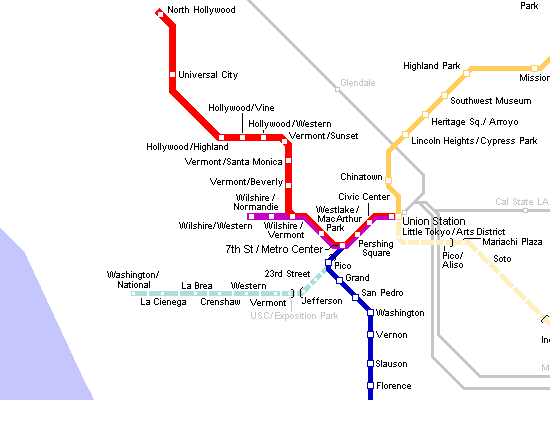If we build it, they will board
July 22, 2010
For decades, the conventional wisdom was that L.A. drivers would never loosen their grip on their steering wheels to embrace public transportation, no matter how infuriating the traffic.
But this summer, as we celebrate the 20th anniversary of the Blue Line light rail between downtown L.A. and Long Beach, we find that the people of Los Angeles County have proven the pundits wrong time and time again. They’re not just riding; they’ve put real money behind the effort to transform our region’s transportation system.
More than a billion boardings have taken place since the Blue Line inaugurated our Metro Rail system two decades ago—dramatic evidence of how our region is beginning to transform itself from a capital of car dominance in the last century into a multifaceted transportation smorgasbord in this one.
This cycle of growth underscores one of the most important lessons of the last 20 years: that the more you build the system, the more of a system you build.
In other words, what we’re creating is more than the sum of its parts. Our transportation system becomes exponentially more useful and popular with the addition of each new element. And small beginnings can grow into big successes. When the Metro Red Line first opened in 1993, L.A.’s first modern subway may have underwhelmed some with its quick, short ride from downtown to MacArthur Park. Now it’ll take you to Hollywood and Vine, Universal City and beyond.
Then there’s the Orange Line, the popular rapid transit busway that runs from Warner Center to North Hollywood and now is being extended northward to Chatsworth. In the line’s first year of operation, more than 30% of the riders who flocked to the line turned out to be newcomers to our public transportation system.
And each alternative we offer adds up to real hours restored to the lives of real people, like the woman who came up to me after the Orange Line opened and emotionally expressed her thanks for the public transportation options that now let her get from her home in the Valley to her job in Long Beach in far less time.
These new options gave her back an hour and a half each day—time she can now spend with her kids.
To make that kind of progress a reality for more people, our region found an important ally in 2008: the ballot box of Los Angeles County.
Even as the economic recession was crashing in on us, voters had the wisdom to overwhelmingly approve Measure R. That provided a half-cent sales tax revenue stream for 30 years to fund transportation projects that are reshaping transportation as we know it in Los Angeles.
Talk about a game changer.
When Phase 2 of the Expo Line project breaks ground next year, the $1.5 billion project will be bankrolled largely by Measure R funds. Slated for completion in 2015, the entire light rail line, paralleling the Santa Monica Freeway, will connect riders from downtown to Exposition Park and USC to Culver City and Santa Monica. It will stand as the first public mass transit project to hit the west side of Los Angeles since the Red Car system was dismantled in the 1950s.
Thanks to Measure R, we are solidly on the right track—with projects across the county that will improve the quality of life for everyone, wherever they live or work.
And now we have the opportunity to really put the pedal to the metal, so to speak, on many of those projects. Under the 30/10 initiative proposed by Mayor Antonio Villaraigosa and backed by Metro’s Board of Directors, of which I am a member, a dozen key projects would be completed in 10 years—instead of 30—by taking out low-interest federal loans to be repaid with Measure R revenue.
The 30/10 plan is not a sure thing, but it’s the right thing—not just for the sake of commuters but for the sake of our Southern California economy, which badly needs the jobs these transit projects would provide.
This accelerated transit building plan is not a magic bullet to solve all of our traffic congestion woes. Realistically, those will be with us as long as there are too many cars for our region’s finite freeway space.
But if we can get the federal assistance we need to make 30/10 a reality, we will be able much more quickly to offer people an ever-increasing set of transit alternatives, including a Green Line that extends to LAX, a regional connector downtown, a Gold Line that runs to Azusa and points east, a subway to Westwood by the end of the decade, and perhaps even a light rail that runs along the 405 Freeway to the San Fernando Valley.
Those projects are part of a new Los Angeles transportation paradigm–one in which trains, buses, bicycles and pedestrians all are important players as we find alternatives to the congested roadways that have eroded our quality of life and limited our access to jobs and cultural attractions.
So when I attend Metro’s official salute to the Blue Line’s 20th anniversary on Friday morning, I will honor all that we’ve accomplished, reflect on all we’ve learned and get ready for all that comes next.
And for our next 20 years, how’s this for a motto: Full speed ahead.
————————–
For a striking visual depiction of how far we’ve come since the Blue Line made its inaugural voyage, check out this interactive timeline map from Metro.
Posted 7/22/10













 405 bridge work causes a stink
405 bridge work causes a stink





